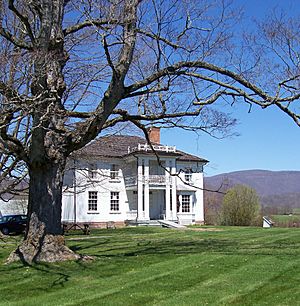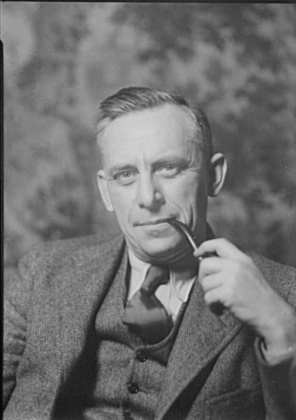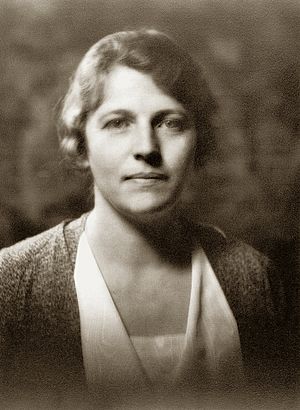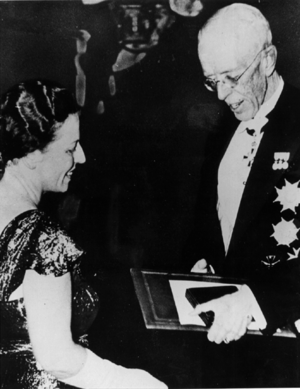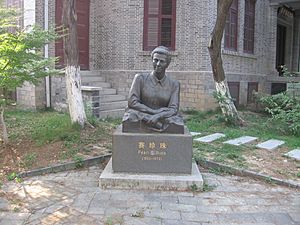Pearl S. Buck facts for kids
Quick facts for kids
Pearl Sydenstricker Buck
|
|
|---|---|
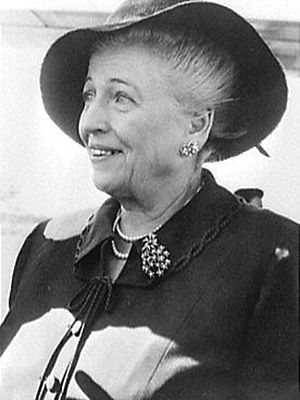
Pearl Buck, c. 1972
|
|
| Born | Pearl Sydenstricker June 26, 1892 Hillsboro, West Virginia, U.S. |
| Died | March 6, 1973 (aged 80) Danby, Vermont, U.S. |
| Resting place | Green Hills Farm Grounds, Perkasie, Pennsylvania, U.S. |
| Occupation | Writer, teacher |
| Alma mater |
|
| Subject | English |
| Notable awards | Pulitzer Prize 1932 Nobel Prize in Literature 1938 |
| Spouse |
John Lossing Buck
(m. 1917; div. 1935)Richard John Walsh
(m. 1935; |
| Signature | |
 |
|
| Pearl S. Buck | |||||||||||
|---|---|---|---|---|---|---|---|---|---|---|---|
| Traditional Chinese | 賽珍珠 | ||||||||||
| Simplified Chinese | 赛珍珠 | ||||||||||
| Literal meaning | Precious Pearl Sy' | ||||||||||
|
|||||||||||
Pearl Sydenstricker Buck (June 26, 1892 – March 6, 1973) was an American writer. She is famous for her novel The Good Earth. This book was a bestseller in the United States in 1931 and 1932. It also won the Pulitzer Prize in 1932.
In 1938, Pearl Buck won the Nobel Prize in Literature. She received it for her amazing stories about farm life in China. She was the first American woman to win this important award.
Pearl Buck was born in West Virginia, USA. But when she was only four months old, her parents took her to China. Her parents were missionaries, and Pearl later became one herself. She spent most of her life in China until 1934. She lived with her parents in Zhenjiang and later with her first husband in Nanjing.
Every summer, her family went to a villa in Kuling, Mountain Lu. It was during these trips that young Pearl decided she wanted to be a writer. She went to Randolph-Macon Woman's College in Virginia, then returned to China. From 1914 to 1932, she worked as a Presbyterian missionary.
However, she started to question if foreign missions were still needed. Her ideas caused some debate, and she eventually resigned. In 1935, she moved back to the United States. She married her publisher, Richard J. Walsh, and kept writing many books. She also became an activist for women's rights and racial equality. She worked hard to help Asian and mixed-race children find families.
Contents
Growing Up and Learning
Pearl Sydenstricker was born in Hillsboro, West Virginia. Her parents, Caroline Maude and Absalom Sydenstricker, were Southern Presbyterian missionaries. They had traveled to China after they got married. But they came back to the U.S. for Pearl's birth.
When Pearl was five months old, her family moved to China. They lived first in Huai'an and then in Zhenjiang starting in 1896. In the summers, they would stay in Kuling. Her father built a stone house there in 1897. He lived there until he passed away in 1931. These summer trips to Kuling inspired Pearl to become a writer.
Pearl had siblings who also grew up to do important things. Her brother, Edgar Sydenstricker, worked for public health. Her sister, Grace Sydenstricker Yaukey, wrote books for young adults about Asia.
Pearl remembered living in "several worlds" in China. One was her parents' "small, white, clean Presbyterian world." The other was the "big, loving merry not-too-clean Chinese world." She felt these two worlds did not connect.
The Boxer Uprising (1899–1901) was a difficult time for her family. Their Chinese friends left them, and fewer Westerners visited. Her father believed no Chinese person would harm him, so he stayed. The rest of the family went to Shanghai for safety.
A few years later, Pearl went to Miss Jewell's School in Shanghai. She was upset by the racist attitudes of other students. Few of them could speak Chinese. Both of Pearl's parents believed Chinese people were their equals. They even banned the word heathen.
Pearl grew up speaking two languages. Her mother taught her English. Her Chinese friends taught her the local dialect. A Chinese scholar named Mr. Kung taught her classical Chinese. She loved to read, especially the novels of Charles Dickens. She said she read them once a year for the rest of her life.
In 1911, Pearl left China to attend Randolph-Macon Woman's College in Lynchburg, Virginia. She graduated with honors in 1914.
Her Work
Life in China
Pearl Buck did not plan to return to China or become a missionary. But her father wrote that her mother was very sick. So, Pearl quickly applied to the Presbyterian Board. In 1914, Buck went back to China.
She married John Lossing Buck on May 13, 1917. He was also a missionary who studied farming. They moved to Suzhou, Anhui Province. This small town is near the Huai River. This is the area she wrote about in her famous books The Good Earth and Sons.
From 1920 to 1933, the Bucks lived in Nanjing. They lived on the campus of the University of Nanking. Both Pearl and John taught there. Pearl taught English literature at this private university. She also taught at Ginling College and National Central University.
In 1920, the Bucks had a daughter named Carol. Carol had a health condition called phenylketonuria. In 1921, Pearl's mother died from a tropical illness. Soon after, her father moved in with them.
In 1924, they left China for a short time. They went to the United States for John's break from work. During this time, Pearl Buck earned her master's degree from Cornell University. In 1925, the Bucks adopted another daughter, Janice. That autumn, they returned to China.
Pearl Buck faced many challenges in the 1920s. In March 1927, there was a violent event in Nanjing. This event involved different groups of soldiers. Several Westerners were killed. Pearl's father insisted they stay in Nanjing. A kind Chinese family helped them hide in their hut. Their own house was looted.
After a day of hiding, American boats rescued them. They traveled to Shanghai and then to Japan. They stayed in Japan for a year. Pearl later said this year showed her that not all Japanese people supported war. When she returned to Nanjing in late 1927, Pearl focused seriously on writing.
She became friends with famous Chinese writers like Xu Zhimo and Lin Yutang. This encouraged her to become a professional writer. She wanted to achieve what her mother could not. She also needed money to support herself if she left her marriage, which had become difficult. The mission board could not pay for Carol's special care.
In 1929, Buck traveled to the United States again. She wanted to find long-term care for Carol. While there, Richard J. Walsh, an editor at John Day publishers, accepted her novel East Wind: West Wind. Pearl and Walsh started a relationship. They later married and worked together for many years.
Back in Nanjing, she wrote in the attic of her university house every morning. Within a year, she finished The Good Earth. She also helped with relief efforts for the 1931 China floods. She wrote short stories about the refugees. These stories were broadcast on the radio in the U.S. and later published.
The next year, her husband took the family to Ithaca. Pearl was invited to speak to a group of Presbyterian women in New York City. Her talk was called "Is There a Case for the Foreign Missionary?" She answered with a clear "no." She said she welcomed Chinese people to share her Christian faith. But she argued that China did not need churches controlled by missionaries. She felt missionaries were often unaware of China and too controlling.
When her talk was published, it caused a scandal. This led Buck to resign from her position with the Presbyterian Board. In 1934, Buck left China. She thought she would return, but her husband stayed.
Life in the United States
The Bucks divorced in Reno, Nevada, on June 11, 1935. Pearl married Richard Walsh that same day. He gave her support and love. Her biographer says this "helped make Pearl's prodigious activity possible." The couple lived in Pennsylvania until Richard's death in 1960.
After the Communist Revolution in China in 1949, Buck was not allowed to return to China. She tried many times. Her 1962 novel Satan Never Sleeps described the Communist rule in China. During the Cultural Revolution, Buck was criticized. She was called an "American cultural imperialist" because she wrote about Chinese village life. Buck was very sad when she could not visit China with Richard Nixon in 1972.
Winning the Nobel Prize
When Pearl Buck gave her speech to the Nobel Academy, she talked about "The Chinese Novel." She explained, "I am an American by birth and by ancestry." But she said her "earliest knowledge of story... came to me in China." She discussed classic Chinese novels. These included Romance of the Three Kingdoms, All Men Are Brothers, and Dream of the Red Chamber.
She concluded that in China, "the novelist did not have the task of creating art but of speaking to the people." Her own goal, she said, was not about "the beauty of letters or the grace of art." In China, a novelist's job was different from a Western artist's. "To farmers he must talk of their land," she said. "And to old men he must speak of peace... and to young men and women he must speak of each other."
She finished by saying that like Chinese novelists, she wanted to write for these people. "If they are reading their magazines by the million," she said, "then I want my stories there rather than in magazines read only by a few."
Helping Others
Pearl Buck cared deeply about many issues that others often ignored. Many of her experiences and beliefs are in her books. She wrote novels, short stories, and children's books. She also wrote biographies of her parents: Fighting Angel (about her father) and The Exile (about her mother).
She wrote about many different topics. These included women's rights, Asian cultures, immigration, adoption, and war. Long before it was popular, Buck spoke out against racism and sex discrimination. She also highlighted the struggles of Asian war children. Pearl Buck balanced being a wife, mother, author, editor, and activist.
In 1949, Buck was upset that adoption agencies thought Asian and mixed-race children could not be adopted. So, she helped start Welcome House, Inc. This was the first international adoption agency for children of different backgrounds. Over almost 50 years, Welcome House helped over five thousand children find homes.
In 1964, Buck started the Pearl S. Buck Foundation. This foundation helps children who cannot be adopted. Its goal is to "address poverty and discrimination faced by children in Asian countries." She opened the Opportunity Center and Orphanage in South Korea in 1964. Later, offices opened in Thailand, the Philippines, and Vietnam.
Buck said the purpose of Opportunity House was "to publicize and eliminate injustices and prejudices suffered by children." She wanted all children to have normal educational, social, and economic opportunities.
In 1960, her husband Richard passed away after a long illness. Pearl Buck renewed a friendship with William Ernest Hocking, who died in 1966. In the late 1960s, Buck raised money to save her family farm in Hillsboro, West Virginia. Today, the Pearl S. Buck Birthplace is a museum and cultural center. She hoped the house would "belong to everyone who cares to go there." She wanted it to be a "gateway to new thoughts and dreams and ways of life."
U.S. President George H. W. Bush visited the Pearl S. Buck House in 1998. He said that he, like many Americans, learned to appreciate the Chinese people through Buck's writing.
Later Life
In the mid-1960s, Pearl Buck became close with Theodore Harris. He was a former dance instructor. He became her trusted friend and helped her with her finances. She started to rely on him for her daily life. She also put him in charge of Welcome House and the Pearl S. Buck Foundation.
Harris was later accused of mismanaging the foundation's money. He was said to have used large amounts for himself and his friends. Buck defended Harris, saying he was "very brilliant, very high strung and artistic." Before she died, Buck signed over her foreign book earnings and personal items to a foundation Harris controlled. This left her children a smaller part of her estate.
Death
Pearl S. Buck died from lung cancer on March 6, 1973. She passed away in Danby, Vermont. After her death, Buck's children challenged her will. They said Harris had too much influence over her in her final years. Harris did not appear in court, and the court ruled in favor of the family.
She was buried at Green Hills Farm in Perkasie, Pennsylvania. She designed her own tombstone. Her name was not written in English on it. Instead, the grave marker has Chinese characters that mean Pearl Sydenstricker.
Her Impact

Many people praised Pearl Buck's writing. They called her prose "beautiful." Peter Conn, who wrote a book about Buck, says that despite her awards, her impact on literature is often forgotten. Kang Liao says Buck helped Americans understand China and its people better.
Phyllis Bentley, who reviewed Buck's work in 1935, was very impressed. She said Buck was a "considerable artist" because of her interesting topics and skill. Reading her novels, Bentley said, gave readers not just knowledge of China but "wisdom about life." Her books helped people feel sympathy for China. They also helped create a more critical view of Japan's actions.
Chinese-American author Anchee Min said she cried after reading The Good Earth as an adult. She had been forbidden to read it growing up in China. Min said Buck showed Chinese farmers "with such love, affection and humanity." This inspired Min's novel Pearl of China (2010), which is a story about Buck's life.
In 1973, Buck was added to the National Women's Hall of Fame. In 1983, the United States Postal Service honored her with a 5¢ postage stamp. In 1999, she was recognized as a Women's History Month Honoree.
Pearl Buck's former home at Nanjing University is now the Sai Zhenzhu Memorial House. Her papers and writings are kept at Pearl S. Buck International and the West Virginia & Regional History Center.
Awards
- Pulitzer Prize for the Novel: The Good Earth (1932)
- William Dean Howells Medal (1935)
- Nobel Prize in Literature (1938)
- Child Study Association of America's Children's Book Award: The Big Wave (1948)
Places to Visit
Several historic places help preserve Pearl Buck's life story:
- The Pearl S. Buck Summer Villa, in Kuling town, Mountain Lu, Jiujiang, China
- Pearl S. Buck House in Nanjing University, China
- The Zhenjiang Pearl S. Buck Research Association and former residence in Zhenjiang, China
- Pearl S. Buck Birthplace in Hillsboro, West Virginia
- Green Hills Farm in Bucks County, Pennsylvania
- The Pearl S. Buck Memorial Hall, Bucheon City, South Korea
See Also
 In Spanish: Pearl S. Buck para niños
In Spanish: Pearl S. Buck para niños
- Christian feminism
- List of female Nobel laureates


